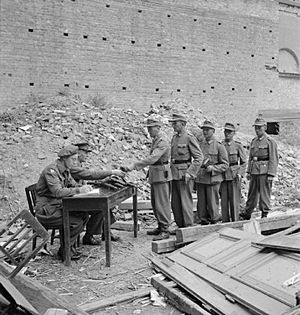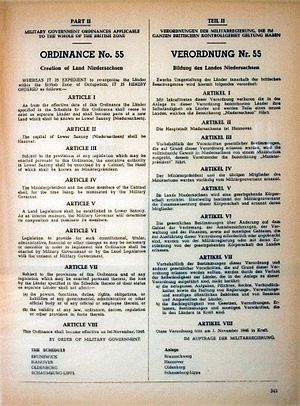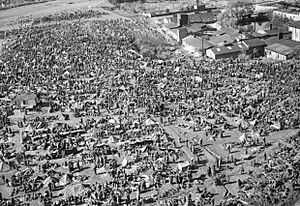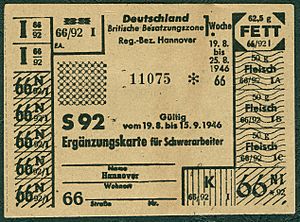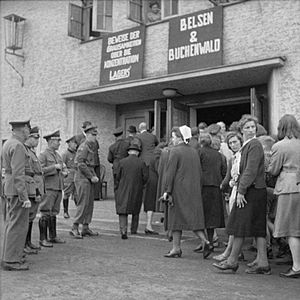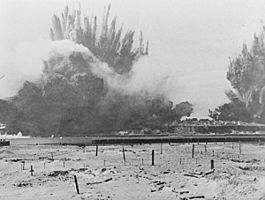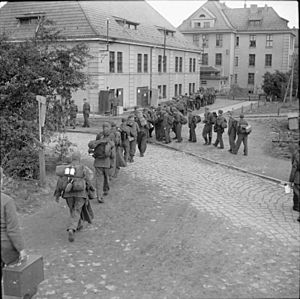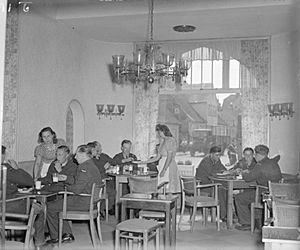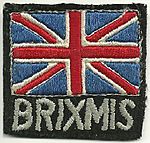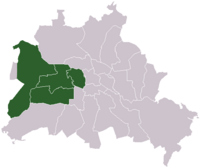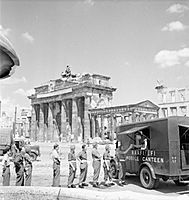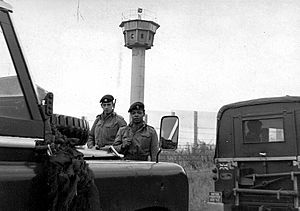British occupation zone in Germany facts for kids
Quick facts for kids British occupation zone in Germany
Britische Besatzungszone Deutschlands
|
|||||||||
|---|---|---|---|---|---|---|---|---|---|
| Military occupation zone of the British part of Allied-occupied Germany | |||||||||
| 1945–1949 | |||||||||
|
|
|||||||||
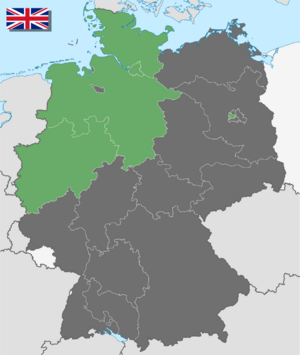 Post-Nazi German occupation borders and territories from 1945 to 1949. British occupation zone (green) - Bremen and Bremerhaven consists of the two grey American exclaves in the British sector. |
|||||||||
| Capital | Bad Oeynhausen | ||||||||
| Government | |||||||||
| Military governor | |||||||||
|
• 1945–1946 (first)
|
Bernard Montgomery | ||||||||
|
• 1947–1949 (last)
|
Brian Hubert Robertson | ||||||||
| Historical era | Cold War | ||||||||
| 8 May 1945 | |||||||||
|
• Allied Control Council
|
5 July 1945 | ||||||||
|
• Disestablished
|
7 October 1949 | ||||||||
| 12 September 1990 | |||||||||
|
|||||||||
| Today part of | Germany | ||||||||
|
|||||||||
The British occupation zone in Germany (German: Britische Besatzungszone Deutschlands) was one of the areas in Germany that the Allied powers controlled after World War II. The United Kingdom, along with its Commonwealth partners, was one of the main Allied powers that defeated Nazi Germany. In 1945, the Allies divided Germany into four zones: British, Soviet, American, and French. This division lasted until 1949, when West Germany was formed. The British zone had the largest population and included important industrial areas like the Ruhr, as well as naval ports and Germany's coastlines.
Contents
How Germany Was Divided After the War
By late 1942, Britain was already planning what to do with Germany after the war. This became more real when the British Liberation Army landed in France on D-Day, June 6, 1944. They fought their way through Northern France and the Low Countries, reaching Germany by the end of the year.
Meanwhile, the "Big Three" leaders – Winston Churchill (Britain), Franklin D. Roosevelt (USA), and Joseph Stalin (Soviet Union) – met at the Yalta Conference in February 1945. They talked about how to occupy Germany after the war and decided on the borders for each zone. They divided "Germany as a whole" into four zones for management. The United States, the United Kingdom, and the Soviet Union each got a zone. This plan was officially agreed upon at the Potsdam Conference in August 1945. Stalin also agreed that France would get a fourth zone, which was created from parts of the American and British zones.
In the final attacks of the war, the British Second Army moved into and took control of much of northwest Germany. When soldiers found concentration camps like Bergen Belsen, it changed how they thought about Germany's future. Removing all Nazi ideas and influence became a top priority for Britain.
On May 4, 1945, Field Marshal Bernard Montgomery accepted Germany's surrender in the Netherlands, northwest Germany, and Denmark. The full German surrender happened three days later. After this, Canadian forces went home, and the British occupied Northern Germany.
For the French zone, the Americans gave up some land in the south. The British gave up areas like the Saarland and parts of the Rhineland. Also, the Inner German Border was created, separating the Western Allied zones from the Soviet zone.
Running the British Zone
In July 1945, Field Marshal Bernard Montgomery became the military governor of the British occupation zone. Brian Robertson was his deputy. Both were also part of the Allied Control Council, which oversaw all four zones. The British Army of the Rhine (BAOR) was formed in August 1945 to manage the British Zone. Its main office was in Bad Oeynhausen. By the end of 1945, about 800,000 BAOR soldiers were in Germany. Many German buildings were taken over for military use, and new barracks had to be built because of war damage, especially in Hamburg.
Different departments were set up to help run the zone. The Property Control Department took over buildings and valuables that had belonged to the Nazis. These items were kept safe until they could be returned to their rightful owners. The Public Safety Department took away all weapons from German soldiers and civilians. A law was passed to make it illegal for German civilians to own any weapons.
The Royal Air Force (RAF) was also part of the occupation, renamed British Air Forces of Occupation (BAFO) in July 1945. Clubs called "Malcolm Clubs" were opened for RAF staff. Two years later, BAFO was much smaller, with only ten squadrons at three airfields.
The Control Commission for Germany (CCG/BE) was created with British government workers and military staff. It took over local government, policing, housing, and transport. The CCG/BE helped rebuild the city of Hamburg as a German state. The British also created three new German states:
- Schleswig-Holstein in 1946.
- Lower Saxony in 1946, by combining several smaller states.
- North Rhine-Westphalia in 1946–47, by combining parts of two Prussian provinces.
In March 1946, a German advisory board was set up for the British zone. It had representatives from states, political parties, and unions. This board could only give advice; the British Control Commission made all the final decisions.
In 1947, the American Zone had no access to the sea. So, the cities of Bremen and Bremerhaven became American areas located inside the British Zone.
Military Governors
- May 22, 1945 - April 30, 1946: Bernard Montgomery
- May 1, 1946 - October 31, 1947: William Sholto Douglas
- November 1, 1947 - September 21, 1949: Brian Hubert Robertson
Helping People: Refugees and Former Soldiers
By June 1945, the British and Americans held over 7.6 million prisoners. About 4.2 million were soldiers captured before Germany surrendered. The British had over 2 million German prisoners of war (POWs) in their zone. It was very difficult to feed, house, and care for so many people. The British struggled to find enough places and guards for them.
Another challenge was the large number of German refugees. Many had fled from the Soviets by sea, and others were forced to leave Eastern Europe. German POWs also returned by sea in huge numbers. This made the housing shortage even worse and led to less food for everyone in early 1946. However, over the next year, many refugees found homes and jobs as the economy slowly improved. Most were given German citizenship.
The British also had to help tens of thousands of displaced persons. Many of these people were from Eastern European countries that the Soviets now controlled, and they did not want to go back. The British first used them for watching and labor. Later, they set up the Mixed Service Organisation, where these displaced persons worked as drivers, clerks, mechanics, and guards. To control the flow of refugees and stop illegal trading, the Frontier Control Service was created in 1946.
Many German POWs were formed into Civilian Labour units. They were still considered "Surrendered Enemy Personnel" but helped with tasks like unloading supplies. The German Civil Labour Organisation (GCLO) was set up in August 1947. Germans could choose to join the GCLO or stay in a POW camp until they were released. By late 1947, over 50,000 Germans worked for the GCLO, helping the British Army and RAF as laborers, drivers, and mechanics. The GCLO was later changed to the German Service Organisation (GSO) in 1950.
In January 1945, the basic food ration for Germans was 1,625 calories per day. By the end of the war in the British zone, this was cut to 1,100 calories. This low level continued into the summer, with some areas like the Ruhr getting only 840 calories per day. To prevent starvation, Britain's Herbert Morrison made a deal with the Americans. The US shipped grain to Germany, and Britain took a smaller share of its own shipments.
The British also faced small resistance groups called Werwolfs. However, these groups did not gain much support from the public, who were tired of war. So, there were few attacks in the British zone.
By late 1946, the British Zone had these populations:
- North Rhine-Westphalia: 11.7 million
- Lower Saxony: 6.2 million
- Schleswig-Holstein: 2.6 million
- Hamburg: 1.4 million
Removing Nazi Influence
After Germany surrendered, the Allied armies searched for important German war criminals and high-ranking Nazis. Britain had a plan since 1942 to remove anyone suspected of supporting Nazi ideas from public and private jobs.
In the first months of the occupation, the British focused on bringing to justice anyone who had committed war crimes. One famous case was Heinrich Himmler, a top Nazi leader. He was arrested by British soldiers in May 1945. The British set up their own British Army War Crimes Investigation Teams (WCIT). Trials took place in the British zone, including the famous Belsen trial after the Bergen-Belsen concentration camp was freed.
The Nuremberg trials also took place between November 1945 and October 1946. This was an "International Military Tribunal" in the American zone, with all four Allied powers involved.
An interrogation center was set up at Bad Nenndorf. It was later closed after reports of mistreatment of detainees. Other smaller trials continued, but by 1948, they became less common. The British government wanted to focus on rebuilding Germany's economy. By 1948, the WCIT had brought about 350 cases to trial, involving over 1,000 accused Nazis. Of these, 667 were imprisoned, and 230 were sentenced to death.
Because 90% of German lawyers had been Nazi Party members, the British decided that 50% of the German legal system could be staffed by "nominal" (not deeply involved) Nazis. They relaxed this rule even more later. The following year, the British handed over all their denazification efforts to the Germans.
There was some disagreement when American prosecutors found evidence that four German officers held by the British were involved in war crimes. The Soviets also asked for them to be handed over. This led to a decision to try these officers. However, tensions grew between British government departments, and a decision was made to stop most other war crimes trials by September 1948.
Removing Weapons and Finding Information
British forces had to get rid of a lot of German war equipment. Many aircraft, tanks, ships, submarines, and huge amounts of weapons had to be destroyed or sunk.
The Royal Air Force destroyed tons of weapons and hundreds of German aircraft. Captured tanks, arms, and vehicles were also scrapped unless they could be used for study. The British army took control of many factories. For example, at the Maschinenfabrik Niedersachsen in Hanover, tanks were built under British supervision. One of its plants was later taken apart, and its parts were sent back to the UK.
The Royal Navy took control of most of the German naval fleet, mainly in Kiel. German submarines were sunk during Operation Deadlight off the coast of Ireland. Some of Germany's large warships were also seized. The German cruiser Prinz Eugen and the light cruiser Nürnberg were escorted to Wilhelmshaven. Other damaged cruisers like Admiral Hipper, Leipzig, and Emden were later broken up for scrap.
The German island of Heligoland in the North Sea was in the British zone and had a large U-Boat base. On April 18, 1947, the Royal Navy set off 6,700 tonnes of explosives to destroy the base. This event, called "Operation Big Bang" or "British Bang," was one of the biggest non-nuclear explosions in history. It changed the shape of the island.
Besides disarming Germany, the British also looked for war secrets and intelligence. They set up new operations to gather information. The Fedden Mission aimed to learn about German aircraft and engines and prevent this knowledge from falling into Soviet hands. Operation Surgeon created a list of 1,500 German scientists and technicians. The goal was to move them out of Germany so the Soviets couldn't get them. Many German scientists were happy to work with the British, with some wanting to move to the U.S. or Canada. About 100 chose to work for the UK.
The British also had enough material to launch V-2 rockets. They set up Operation Backfire in October 1945 to show how the weapon worked. German personnel operated the launches because they were the only ones who knew how. Four rockets were launched, with one reaching an altitude of about 80 kilometers (50 miles).
-
Two members of a Royal Air Force Disarmament Wing check an aircraft wreckage dump at Flensburg airfield
The Target Intelligence Committee (TICOM) was a secret project to find German intelligence secrets, especially in code-breaking. This was a joint British-American project. Teams of code-breaking experts went to Germany after the war to find documents, technology, and people from German intelligence groups before they could be destroyed or captured by the Soviets. A major discovery was the "Russian FISH," which were German receivers used to listen to Soviet radio signals. These were sent to England and used to listen to Russian radio traffic.
Farming and Factories
Between June and September 1945, over 300,000 Germans (non-Nazi soldiers) were released by the British to work on farms and help with the harvest. This project, called Operation Barleycorn, was successful. As a result, more prisoners were released to work in transport and mining.
Much of Germany's industry was in the British zone, especially the important industrial area of the Ruhr. There was concern that rebuilding Germany's factories might make it a danger to British security later. In January 1946, the Allied Control Council limited how much steel Germany could produce. The British wanted a higher limit, but had to agree to a lower one set by the US, France, and the Soviet Union. Steel plants that were no longer needed were taken apart by the Allies, and the materials were sent back to their own countries.
The Ruhr area produced 93% of all coal in Germany. The British did not want the Soviets to have influence in the Ruhr. British Foreign Secretary Ernest Bevin and US Secretary of State George C. Marshall agreed that the Ruhr's industries should help the economy of war-torn Europe.
In Essen, the British set up their headquarters for North German Coal Control. From there, they managed the production and distribution of coal from all the Ruhr coal fields. The Royal Engineers repaired much of the transport system, but there was a big shortage of workers. To find more workers, the British started Operation Coal Scuttle in autumn 1945. They released 30,000 former soldiers to work in the coal mines. Still, this was not enough to reach pre-war production levels.
The destroyed German transportation system caused many problems. Rail lines, bridges, canals, and terminals were in ruins. Only 1,000 of the 13,000 kilometers of track in the British zone could be used. Cities often had to be supplied using horse-drawn carriages and carts.
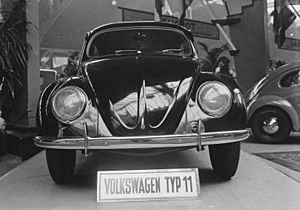
One of the many factories the British took over was the Volkswagen plant at Wolfsburg in June 1945. Major Ivan Hirst of the Royal Electrical and Mechanical Engineers (REME) helped revive the factory, which had been badly damaged by air attacks. Hirst fixed the drains and filled bomb craters. He found an undamaged Volkswagen Beetle inside the factory. Hirst realized that making affordable cars would help with the British Army's transport problems. In August, he received an order to produce many Volkswagen Beetles for the British military. Cars were put together using old parts. By 1946, the factory produced about 1,000 cars a month. Civilian production started in December 1945, making Wolfsburg the first car factory in Germany to restart after the war. By 1948, total production reached over 19,000 cars. Hirst also set up a system for exporting cars to the Netherlands.
The British Army also helped other German businesses, like the KWS Grain Factory and the Huth-Apparatebau radio factory in Hanover. The radio factory hired local people to make radios from parts salvaged from German military equipment.
To help Germans become self-sufficient, the British supported the creation of strong, free trade unions. In early 1947, several unions joined to form the Gewerkschaftsbund in der britischen Besatzungszone. The Deutscher Gewerkschaftsbund (DGB) was founded in Bielefeld in April as a group of twelve unions. By June 1949, the DGB in the British zone had about 2.8 million members.
To solve the issue with the Ruhr, an Authority was set up in June 1948. This Authority would "supervise the production, organization, trade and ownership policies of the Ruhr industries." It would also "distribute their products so that all countries cooperating for the common economic good will have adequate access to them." The plan for the International Authority for the Ruhr (IAR) was signed and began in April 1949.
Media and Sports
In 1946, a short film called A Defeated People was made. It showed how damaged Germany was after the war. The film was one of the first to show the war's impact on ordinary German people and what needed to be done to rebuild Germany.
A radio station was set up in Hamburg by British authorities to give information to the public. Hugh Carleton Greene from the BBC was sent to create a public broadcasting service. On September 22, 1945, Radio Hamburg became Nordwestdeutscher Rundfunk (NWDR).
In Hanover, Major John Seymour Chaloner helped set up a magazine called Diese Woche (meaning This Week). It was first published in November 1946. Challoner worked with a German former prisoner of war, Rudolf Augstein. The magazine was later renamed Der Spiegel and first published under that name in January 1947.
The British also helped bring back association football (soccer) in Germany. An attempt was made to hold a German football championship in 1947, but it didn't work out. The 1947 British occupation zone football championship saw the best teams in the region compete, with Hamburger SV winning. Eventually, a German championship was held with teams from all four zones. In the 1948 German football championship, 1. FC Nürnberg became the champions.
Sub-Zones within the British Zone
Army units from other countries were also stationed within the British occupation zone.
Belgium
Belgian army units were given a sector on April 1, 1946. They controlled a 200-kilometer (124-mile) strip from the Belgian-German border. This area included cities like Aachen, Cologne, and Kassel.
Poland
Polish units, including the 1st Armoured Division, were stationed in the northern area of the Emsland district, as well as Oldenburg and Leer. Their main administrative center was the city of Haren, which was renamed Maczków (after their commander Stanisław Maczek) from 1945 to 1947. Polish units were demobilized (sent home) in June 1947.
Norway
The Independent Norwegian Brigade Group in Germany had 4,000 soldiers based in Hanover. Their headquarters later moved to Oerlinghausen, Neumünster, and Rendsburg.
Denmark
A Danish Brigade in Germany of 4,000 men, under British command, was sent to occupy Oldenburg in summer 1947. This was after an agreement between Denmark and the United Kingdom. A Danish Occupation Force was officially created in October 1949. It remained stationed in Itzehoe until 1958.
Netherlands
In April 1949, the Netherlands was given some small border changes. Dutch troops moved to occupy an area of 69 square kilometers (17,000 acres). The most important parts were Elten and Selfkant. Other small border changes were made near Arnhem and Dinxperlo.
The Cold War Begins
Under an agreement, the British had to give some areas of their zone to the Soviet Union. This included parts of Hanover and Brunswick. The British also exchanged some villages between British Holstein and Soviet Mecklenburg. The British helped all the inhabitants of the villages being given to the Soviet zone to evacuate.
BRIXMIS: Spying and Liaison
To exchange military missions between the British and Soviet zones, an agreement was made in September 1946. This led to the creation of the British Commanders'-in-Chief Mission to the Soviet Forces in Germany (BRIXMIS). The Soviets had a similar mission in the British Zone called 'SOXMIS'. The goal was to "maintain Liaison" (keep in touch) between the military leaders and their governments in the zones. These missions were given passes to travel freely, except in certain restricted areas.
Although not openly stated, these missions were also used to gather military intelligence through looking around and watching. The British Mission included members of the British Army, Royal Navy, and Royal Air Force. They drove marked cars and flew small planes.
From Bizone to Trizone
Cooperation between the Western Allies and the Soviets eventually broke down because they disagreed about Germany's future. On January 1, 1947, the British and Americans combined their zones. This new area was called the Bizone. This was done to work together better on politics and economy. In May 1947, the American and British military governments signed an agreement to create an Bizonal Economic Council for the Bizone, based in Frankfurt am Main.
In April 1947, the first state elections were held in the British sector. The creation of the Bizone was a very important step in forming two separate groups (blocs) in Europe, which led to the Cold War. When the French occupation zone was added on August 1, 1948, the area became known as the Trizone.
In March 1948, the Soviets left the Allied Control Council. They had learned about Allied plans to create a new West German state. The Cold War was truly beginning. On June 18, the United States, Britain, and France announced that a new currency, the Deutsche Mark, would be introduced. The Soviets refused to allow it in Berlin.
Berlin and the Airlift
The British, along with the other three Allied powers, also had a separate occupation zone within the capital city of Berlin. This was deep inside the Soviet occupation area. The British sector (165.5 square kilometers or 64 square miles) included areas like Tiergarten and Spandau. The Olympic Stadium became the headquarters for the British. Spandau Prison was also in the British sector and was used by all four powers to hold Nazi war criminals.
On June 24, 1948, the Soviets blockaded Berlin. This meant they stopped all land and water routes into West Berlin. At the time, West Berlin had only enough food for 36 days and coal for 45 days. The Americans and British were greatly outnumbered militarily because their armies had been made smaller after the war. British forces were around 7,606.
During the blockade, the British, with help from pilots from Canada, Australia, New Zealand, and South Africa, carried out an airlift called "Operation Plainfare." RAF Gatow airfield was improved with a new concrete runway. This airfield was key during the airlift. The RAF quickly increased its number of aircraft. They flew additional planes from Britain, bringing their fleet to about 150 Douglas Dakotas and 40 larger Avro Yorks. To save time, many flights did not land in Berlin. Instead, they air-dropped materials like coal onto the airfields. Short Sunderland flying boats flew from Finkenwerder near Hamburg to the Havel river next to Gatow. Their special hulls allowed them to deliver baking powder and salt into the city.
On May 4, 1949, the Soviets lifted the blockade. They realized they could not shoot down the aircraft without starting a war. The British contributed 541,937 tons of supplies and food out of a total of 2,326,406 tons delivered. Eight aircraft were lost in accidents, and 40 personnel died.
-
NAAFI Mobile Canteen No.750 beside the Brandenburg Gate 16 July 1945
-
An RAF Douglas Dakota is towed out of a hangar at RAF Lubeck, after maintenance in April 1949 during the Berlin airlift
End of the Occupation
On April 10, 1949, the Occupation statute was created by American, British, and French representatives. This document explained the roles of the new government of the Federal Republic of Germany (West Germany). It gave them conditional independence. However, the Allies still had the right to keep occupation forces and perform administrative duties in the country.
In July, the Enclave of Bonn was created. Since it was in the British zone, the city was not under British or any other Allied control. Instead, it was led by the Allied High Commission. In October, the Soviet zone was declared the German Democratic Republic (GDR), under communist rule. In June of the next year, Ivone Kirkpatrick became the British High Commissioner for Germany. Kirkpatrick had a lot of responsibility, especially in negotiating the Bonn–Paris conventions from 1951 to 1952. These agreements ended the occupation and prepared the way for West Germany to rearm. They came into effect on May 5, 1955.
High Commissioners
- September 21, 1949 - June 24, 1950: Brian Hubert Robertson
- June 24, 1950 - September 29, 1953: Ivone Kirkpatrick
- September 29, 1953 - May 5, 1955: Frederick Hoyer-Millar
After the Occupation Ended
In 1955, the Federal Republic of Germany became a fully independent state. The Western occupation zones no longer existed, and the high commissioners were replaced by ambassadors. However, the four Allied powers still had special rights and responsibilities in Germany until the Final Settlement in 1990.
From November 1951, Canadian forces also sent about 10,000 soldiers to bases around Soest. By 1970, this number was reduced to less than 3,000 men, and they moved to Lahr.
In 1954, the British Army headquarters moved to Mönchengladbach. The RAF in Germany was renamed Royal Air Force Germany (RAFG). British troops still guarded the Inner German Border. The British Frontier Service played an important role in managing tensions there. Its officers were called to border incidents to help solve problems and provide a British view. This continued until German reunification in 1991.
The British Army of the Rhine (BAOR) and RAFG were disbanded in 1994, after the end of the Cold War. This meant that British Armed Forces in Germany were greatly reduced. By the late 1990s, only one division remained. After this, UK forces became known as British Forces Germany, and in 2020, they were renamed British Army Germany.
Cultural Impact
- The German fast food dish currywurst was invented in Berlin in 1949. The creator, Herta Heuwer, got tomato ketchup, Worcestershire sauce, and curry powder from British soldiers in the city.
- The 2019 film The Aftermath is based on a novel and shows events in the British occupation zone around Hamburg in the winter of 1946.
See also
- List of administrators of Allied-occupied Germany
- Allied-occupied Austria
- Interzonal traffic




